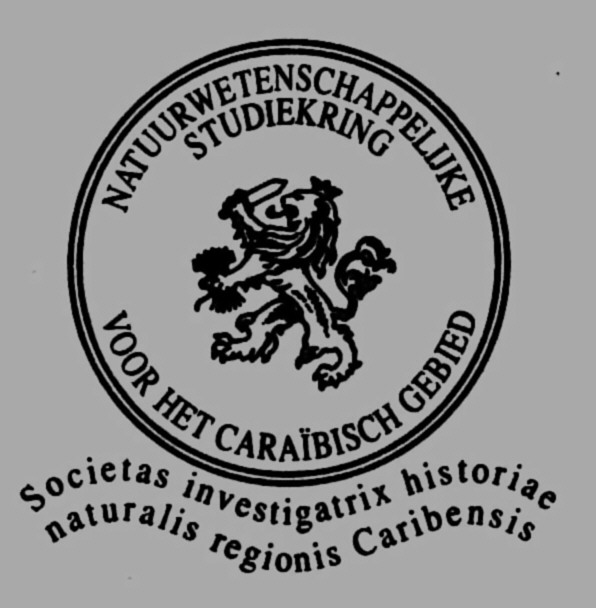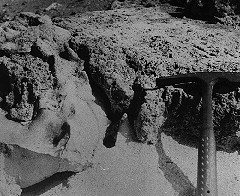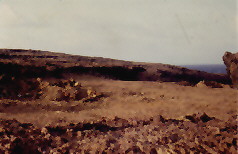Phosphate rock on the Netherlands Antilles
Phosphate rock on the Netherlands Antilles
Introduction
In 1991 I published my thesis on
SEDIMENTARY PETROLOGY, ORIGIN AND MINING HISTORY OF THE PHOSPHATE
ROCKS OF KLEIN CURACAO, CURACAO AND ARUBA, NETHERLANDS WEST
INDIES
This book (ISBN 90-74624-01-4) can be ordered at:

Foundation for Scientific Research in the Caribbean Region
Plantage Middenlaan 45
1018 DC Amsterdam
the Netherlands
It is volume 130 in their Publication series. It costs about NLG 60,--
(about US$ 35). The Publication Series contains many more very
interesting titles on the biology, geology, and natural history in
general of the (Netherlands) Caribbean islands. A must
for Caribean natural scientists, and others interested in this topic!!
As an introduction to this publication I enclose on this page:
- the contents
- an excerpt of the summary in English.

Contents
Chapter 1
Introduction
1.1 Introduction
1.1.1 Origin and aim of the research
1.1.2 Structure of the report
1.2 Research methods
1.2.1 Fieldwork
1.2.2 Topographic maps and aerial photographs
1.2.3 Sampling
1.2.4 Laboratory research

Chapter 2
Setting of the southern Netherlands West Indies
 2.1 Geographic setting
2.1 Geographic setting
2.2 Tectonic setting
2.3 Geological research
2.4 Late Quaternary sea-level fluctuations
2.4.1 Eustatic sea-level fluctuations
2.4.2 Sea-level records on the Antillean islands
2.4.3 Discussion and conclusions
2.5 Hydrographic setting
2.6 Climate
2.6.1 Wind
2.6.2 Temperature
2.6.3 Rainfall
2.6.4 Relative humidity and surface waters
2.7 Soils
2.8 Flora
2.9 Fauna

Chapter 3
Phosphorus-rich rocks - nomenclature, classification, and petrographic
terminology
3.1 Phosphorus in the lithosphere
3.2 Basic terminology of phosphorus-rich rocks
3.3 Basic chemistry of phosphate rocks
3.4 Classification of main groups of phosphate rocks
3.4.1 Primary phosphate rocks
3.4.2 Secondary phosphate rocks
3.4.3 Distinction between phosphate rock types
3.5 Principles of phosphorite petrography
3.6 Phosphorite petrography - textural elements
3.6.1 Grain types
3.6.2 Matrix and cement
3.7 Phosphorite classification system

Chapter 4
Phosphorites of Klein Curacao
 4.1 Introduction
4.1 Introduction
4.1.1 Geographical and geomorphological setting
4.1.2 Geological setting
4.1.3 Previous research
4.1.4 Field survey and sampling
4.2 General stratigraphy
4.3 Petrology
4.3.1 Bioclastic calcarenites and calcilutites
4.3.2 Moderately to well sorted bioclastic calcarenites
4.3.3 Peloidal calcilutites
4.3.4 Phosphorites
4.4 Mineralogy and geochemistry
4.5 Discussion and conclusions
4.5.1 Origin of the investigated deposits
4.5.2 Origin of the phosphorus

Chapter 5
Pinnacle field phosphorites, Table Mountain, Curacao
 5.1 Introduction
5.1 Introduction
5.1.1 Geographical, geological and geomorphological setting
5.1.2 Phosphorite occurrences
5.1.3 Previous research
5.2 General stratigraphy
5.3 Petrology
5.3.1 (Dolomitic) terrace limestones
5.3.2 Dolomite
5.3.3 Crystalline calcite
5.3.4 Calcrete
5.3.5 Oolitic phosarenite
5.3.6 Rubble phosphorite
5.4 Mineralogy and geochemistry
5.5 Discussion and conclusions
5.5.1 Setting of the investigated deposits
5.5.2 Development of the investigated deposits
5.5.3 Origin of the phosphorus

Chapter 6
Phosphatized limestones of Table Mountain Santa Barbara, Curacao
 6.1 Introduction
6.1 Introduction
6.1.1 Geological and geomorphological setting
6.1.2 Previous research
6.1.3 Method of processing drilling data
6.2 Stratigraphical setting - characteristics of the Ceru Domi Formation
6.2.1 Petrology of Ceru Domi Formation limestones
6.2.2 Stratification within the Ceru Domi Formation
6.2.3 The basal plane of the Ceru Domi Formation
6.2.4 General chemistry of Ceru Domi limestones
6.2.5 Horizontal extent of the phosphatized zone within the Ceru
Domi Formation
6.2.6 Vertical extent of the phosphatized zone within the Ceru Domi
Formation
6.2.7 Chemical trends within the phosphatized zone
6.3 Petrology of the phosphatized limestones - lenticular phosphate bodies
in the western excavations
6.3.1 Zone 1: non-phosphatic limestones
6.3.2 Zone 2: partly phosphatized limestones
6.3.3 Zone 3: completely phosphatized limestones
6.3.4 Zone 4: laminated phosphate cement ('multipartite phosphate')
6.3.5 Zone 5: central void
6.4 Petrology of the phosphatized limestones - non-lenticular phosphate
zones in the eastern excavations
6.5 Mineralogy and geochemistry
6.6 Discussion and conclusions
6.6.1 Spatial differences in degree of diagenesis
6.6.2 Diagenetic sequence
6.6.3 Phosphate source and age of phosphatization

Chapter 7
Phosphorites of south-east Aruba
 7.1 Introduction
7.1 Introduction
7.1.1 Geological setting
7.1.2 Geology of south-east Aruba
7.1.3 Previous research
7.2 Stratigraphic setting
7.3 Petrology
7.3.1 Detrital peloidal phosarenites
7.3.2 Ferruginous phosphorites
7.3.3 Calcareous phosphorites
7.3.4 Phosphatic "pebbles"
7.4 Mineralogy and geochemistry
7.5 Discussion and conclusions
7.5.1 Origin of the Aruba phosphorites
7.5.2 Diagenetic events
7.5.3 Phosphate sources
7.5.4 Age estimate

Chapter 8
Geology of the phosphate rocks of Curacao, Klein Curacao and Aruba
- summary and conclusions
8.1 Introduction
8.2 Lateral and vertical extent
8.3 Internal organization
8.4 Petrololgy
8.5 Diagenesis
8.5.1 Diagenesis in granular phosphorites
8.5.2 Diagenesis in Table Mountain rock phosphates
8.5.3 Mechanisms of phosphate emplacement
8.5.4 Spatial distribution of diagenesis
8.6 Mineralogy and geochemistry
8.6.1 Mineralogy
8.6.2 Geochemistry
8.6.3 Impact of weathering
8.7 Conclusions

Chapter 9
The economic history of phosphate mining on Klein Curacao, Curacao,
Aruba and Bonaire
9.1 Introduction
9.2 Phosphate rocks on Klein Curacao
9.2.1 Introduction
9.2.2 Phosphate mining on Klein Curacao
9.2.3 Value of phosphate mined on Klein Curacao
9.3 Phosphate rocks on Table Mountain, Santa Barbara, Curacao
9.3.1 The first exploitation period (1875-1895)
9.3.2 No operations (1896-1912)
9.3.3 The second exploitation period (1913-present)
9.4 Other phosphate rocks on Curacao
9.5 Phosphate rocks on Aruba
9.5.1 Introduction
9.5.2 Phosphate production - amounts and values
9.5.3 Government phosphate mining revenues
9.6 Phosphate rocks on Bonaire
9.7 Summary

Excerpt of the Abstract
Chapter 1 summarizes the main objective of the study and the research
methods applied.
Chapter 2 deals with different aspects of the setting of the
investigated islands, the core of which is of
volcanic origin, but the rim of which consists of detrital
sediments. These sediments record a histry of
eratic uplifting. A tentative correlation is presented
between specific Pleistocene sea-level
maxima and certain coastal terraces.
Chapter 3 presents a basic petrographic terminology for phosphate rocks
The following four chapters describe in detail the petrology and origin of the
phosphate rocks of Klein Curacao (Chapter 4), the phosphorites which occur in
pinnacle fields on the southern slope of Table Mountain, Curacao (
Chapter 5), the rock
phosphates within the main body of Table Mountain, Curacao (Chapter 6) and the
phosphorites of south-east Aruba (Chapter 7).
Chapter 8 summarizes and reviews the similarities and differences
between the various
Antillean phosphate rocks, and presents a synthesis of
these features. Several petrographic subunits are
recognized, which document successive phases of phosphorite
emplacement. The material was derived
from different sources, including older phosphate deposits
and fresh calcareous, evaporitic and
siliciclastic sources. The genetic environment generally was
peri-marine, but suffered intense land
dominated processes.
Chapter 8 also comments on diagenesis of the phosphate rocks,
which includes three successive
diagenetic mechanisms of phosphate cementation, limestone dissolution
and continued metasomatic
phosphatization. Type and degree of phosphatization appears, at
least partly, to have been defined by
carbonate mineralogy.
Finally, Chapter 9 provides a summary of the history of
phosphorite mining on Klein
Curacao, Curacao, Aruba and Bonaire. It is concluded that
between 1871 and 1985 a
total of at least 6 million metric tonnes of guano,
phosphorite and other types of
phosphate rock were exported with an estimated value of
at least 300 million guilders.

c101/updated 2004-12-24


 2.1 Geographic setting
2.1 Geographic setting 4.1 Introduction
4.1 Introduction 5.1 Introduction
5.1 Introduction 6.1 Introduction
6.1 Introduction 7.1 Introduction
7.1 Introduction